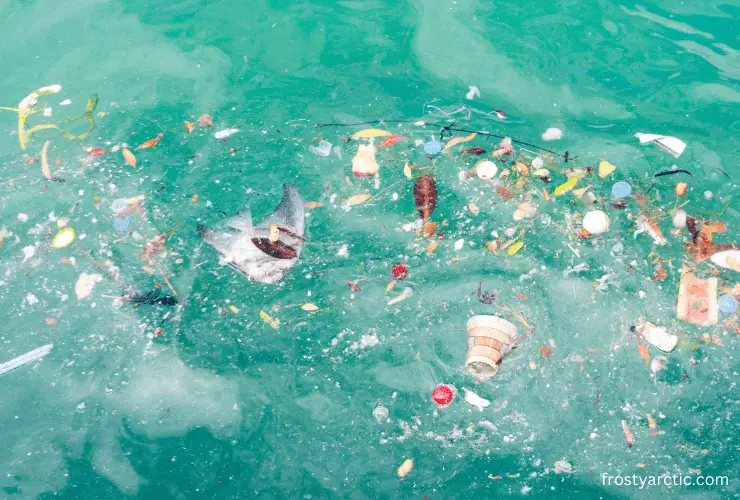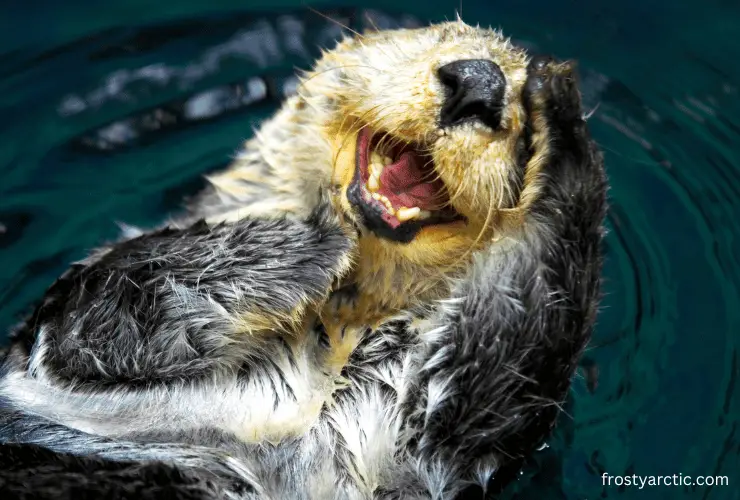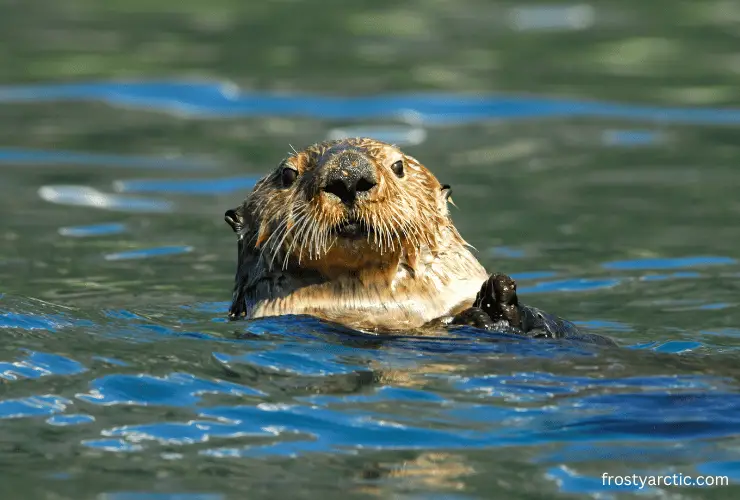Sea otters are endangered due to human activities and climate change. Key factors include ocean pollution, overfishing, habitat loss, illegal hunting for their thick fur, predation, and disease. The result is that a whirlpool of such problems has pulled their numbers down to frightening lows.
Sea otters play a much more significant part in our environment than many realize. They are important for maintaining the health of kelp forests.
But “Why are sea otters endangered?” Let’s plunge into the depths of this issue together.
We’ll explore the threats sea otters face and the cascade effect their decreasing numbers could have on our blue planet. Because remember, when one link in the chain of life breaks, the whole ecosystem can feel the impact.
Current Status of Sea Otters – Are They Endangered?
Sea otters are currently classified as ‘Endangered’ on the IUCN Red List. This means if the threatening conditions persist, they’re in grave danger of going extinct.

Sea otters play an essential role in our ocean’s ecosystems. But sadly, their numbers have been dropping for years. They were once hunted on a large scale for their rich, insulating fur. This led to a massive drop in their population in the 1900s, from hundreds of thousands to only two thousand. ~ Source.
Seeing the impending disaster, the 20th century witnessed a surge of protective measures to stop this slide toward extinction. These include the International Fur Seal Treaty of 1911 and the Endangered Species Act of 1973.
But the journey to recovery is not a smooth ride. Despite efforts, sea otters still grapple with numerous threats that endanger their survival. Even today, they walk a tightrope between existence and extinction.
A Snapshot of Sea Otter Populations – How Many Sea Otters Are Left?
Based on large-scale population reductions in the past, over half of the sea otters are estimated to have disappeared in the previous 45 years. ~ Source
The sea otter population is divided into three subspecies:
- The Asian sea otter (Enhydra lutris lutris)
- The Northern sea otter (Enhydra lutris kenyoni)
- The Southern sea otter (Enhydra lutris nereis).
Each subspecies has a different status and trend:
- The Asian sea otter family found in Russia and Japan is considered vulnerable by the IUCN, while its population is unknown ~ Source.
- The Northern sea otter living in Alaska, British Columbia, and Washington have a population of 51,935 individuals. It is classified as endangered by the IUCN ~Source.
- The Southern sea otter inhabiting California and Baja California has a population of 2,962. They’re considered threatened under the U.S. Endangered Species Act and endangered by the IUCN ~ Source.
| Sea Otter | Location | Population | Status |
| Asian sea otter | Russia and Japan | – | Vulnerable |
| Northern sea otter | Alaska, British Columbia, Washington | 51,935 | Endangered (IUCN) |
| Southern sea otter | California and Baja California | 2,962 | Threatened (U.S. Endangered Species Act)Endangered (IUCN) |
Though the sea otter population has shown signs of recovery since the fur trade ban in 1911, it is still far from its historical population of 150,000–300,000 before the fur trade in the 18th and 19th centuries.
Some populations are growing, while others are holding steady or, sadly, decreasing. According to the IUCN, the overall trend for otters is still in decline.
What is the Biggest Threat to Sea Otters?

According to the U.S. Geological Survey (USGS), one of the biggest dangers sea otters face is oil spills. The thing is, sea otters are particularly vulnerable to the harm caused by oil contamination.
Unlike other mammal species, sea otters lack a layer of fat. Instead, they depend on their dense fur to keep themselves warm. When this fur becomes coated in oil, it loses all its warming powers. This leaves the otters with hypothermia (their body temperature drops too low).
Plus, when otters try to clean off the sticky oil from their fur, they can accidentally ingest it. This can cause serious health problems like kidney damage and ulcers and even be fatal. So, oil spills aren’t just a threat to our environment, but also they are a direct threat to the survival of otters too.
One devastating example of this threat was the Exxon Valdez oil spill in 1989. The spill killed thousands of sea otters in Prince William Sound, Alaska ~ Source. In the aftermath, researchers found that the sea otter population in heavily oiled areas took almost 25 years to recover ~ Source.
Moreover, oil spills can indirectly impact sea otters by damaging their habitats and ruining their food sources. This shows how big of a problem oil spills can be for sea otters.
Other Causes of Sea Otters Extinction
Beyond oil spills, sea otters face several other challenges threatening their survival.
1. Ocean Pollution

Human activities, such as farming, industrial processes, and urban runoff, introduce pollutants like pesticides, heavy metals, and toxins into the ocean.
Sea otters are susceptible to these pollutants as they bioaccumulate in their prey, causing health issues in otters.
Long-term exposure to these contaminants can reduce otters’ immunity, reproductive capacity, and lifespan, leading to population declines.
2. Overfishing and Competition for Food
Overfishing is a critical concern for sea otters. Humans, commercial fisheries, and sea otters often target the same seafood. Overfishing can cause a decline in prey species, leading to food scarcity for otters.
With less food available, otters can become malnourished, reducing their survival and reproduction rates, leading to population declines.
3. Habitat Loss and Degradation
Coastal development and human activities lead to habitat loss and degradation for sea otters. This includes physical changes to coastlines, disruption of kelp forests (their primary habitat), and increased human-sea otter interactions, leading to disturbances and stress.
4. Poaching
Despite protective laws, illegal hunting or poaching remains a persistent threat to sea otters. Their dense, luxurious fur is highly prized in the illegal fur trade. Poaching directly reduces sea otter numbers and can disrupt their social structure, leading to decreased reproduction and growth of populations.
5. Predation and Disease
Natural predators like sharks, killer whales, and eagles can cause significant fatalities in sea otter populations, particularly where their numbers have increased due to shifts in ecosystem dynamics.
Disease, notably the parasite Toxoplasma gondii, which comes from cat feces, causes many sea otter deaths annually. Otters can ingest the parasite when they eat contaminated prey, leading to brain inflammation and, often, death ~ Source.
6. Climate Change
The long-term effects of climate change could significantly impact sea otters. As sea temperatures rise, prey species could shift their geographical range, causing food shortages for otters.
Increased storm activity due to climate change could lead to more frequent oil spills and coastal erosion, further degrading sea otter habitats.
Additionally, acidification of oceans due to increased CO2 absorption can affect shellfish populations, impacting the food availability for otters. All these climate change effects can lead to a decline in sea otter populations.
Consequences of Sea Otters Endangerment

The endangerment of sea otters has effects extending beyond the species. Their decline severely affects their ecosystems and local biodiversity.
1. Impact on Kelp Forests
Sea otters are considered a keystone species. They help in maintaining the health and stability of their ecosystems ~ Source. One of the primary ecosystems sea otters inhabit is the kelp forest.
Sea otters munch on sea urchins, which love to feed on kelp. So, the sea urchin population can skyrocket in places where sea otters are missing, or there aren’t many. This can result in the urchins overeating the kelp, forming an ‘urchin barren.’~ Source.
Kelp forests are vital marine habitats that provide food and shelter for various species. They also take in carbon dioxide, which helps control our climate.
So, declining sea otter populations can also destroy kelp forests. And this, in turn, can impact the diversity of marine life and global climate change.
2. Effects on Local Biodiversity
The decline of sea otters also directly impacts local biodiversity. As sea otter populations shrink, the unchecked growth of their prey, such as crabs, can disrupt the balance of the local ecosystem.
For instance, increased crab populations due to a lack of sea otters can decrease the number of sea slugs, a favorite food of crabs.
Sea slugs play a vital role in controlling algae growth on seagrass. Therefore, a decline in their numbers can result in the overgrowth of algae and the subsequent degradation of seagrass meadows ~ Source.
Conservation Efforts – What is Being Done to Protect Sea Otters?

All hope is not lost. Many conservation efforts are in motion to protect these creatures and recover their population.
● Legislative Protections
Legal protections provide a strong foothold in our effort to safeguard sea otters. Within the U.S., the Marine Mammal Protection Act of 1972 and the Endangered Species Act of 1973 are strong walls against threats. These laws strictly outlaw hunting, capturing, or disturbing sea otters and forbid dealings with their body parts or by-products.
● Research and Monitoring
Continued research and study of sea otter populations help to learn about their habits, health, and the threats they encounter. Such research paves the way for the crafting of tailor-made conservation plans.
● Rescue and Rehabilitation
Organizations like the Marine Mammal Center and Monterey Bay Aquarium play a vital role as the sentinels of sea otter conservation. They step in as the emergency response team, rescuing and healing injured, ill, or orphaned sea otters and, when feasible, reintroducing them to their ocean homes.
● Reintroducing Sea Otters to their Natural Habitats
Reintroducing sea otters to their habitats has been the most helpful step in saving them from almost dying out in parts of the eastern North Pacific. It’s crucial for their survival.
They probably won’t return to their old region without a solid effort to reintroduce otters to their natural habitats. This would leave them susceptible to threats (like oil spills) and make it harder to resist growing problems like climate change.
● Public Engagement and Education
The key to conservation lies in our hands. Through public participation and education, we can illuminate the significance of sea otters and the challenges they face. These efforts inspire individuals and communities to take action.
This includes encouraging responsible behavior in sea otter habitats, supporting conservation organizations, and advocating for policies that protect sea otters and their environments.
● Habitat Preservation
Efforts to preserve and restore sea otter habitats, such as establishing marine protected areas, contribute to the resilience of sea otter populations. These protected areas protect crucial feeding and breeding grounds from harmful human activities.
Together, these conservation efforts are making a difference for sea otters. While challenges remain, the dedication of scientists, conservationists, policymakers, and the public gives us hope that we can secure a future for these helpful creatures.
FAQs about Why Are Sea Otters Endangered
Q: How can we save sea otters on an individual level?
We can save sea otters by reducing our environmental impact:
- Reduce, reuse, and recycle to prevent waste and plastic pollution in the ocean.
- Dispose of hazardous wastes properly and use nontoxic household cleaning products to avoid water contamination.
- Don’t litter or dump materials into storm drains to protect sea otter habitats from flooding, erosion, and pollution.
Q: Where are sea otters most endangered?
A: Sea otters are the most endangered along the coasts of California, Washington, and parts of Alaska.
Conclusion
The question “Why are sea otters endangered?” reveals a complex web of threats – from climate change to human activities like pollution and hunting. The decline of these animals impacts the ocean ecosystems, highlighting their critical role, particularly in kelp forests.
Recovery initiatives, like reintroducing otters to their natural habitats and enforcing legal protections, offer some hope. However, it’s essential to further these efforts and increase public awareness to ensure the survival of these incredible creatures.



4 thoughts on “Why Are Sea Otters Endangered? [Reasons Explained]”